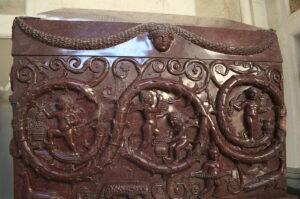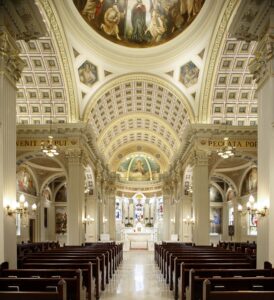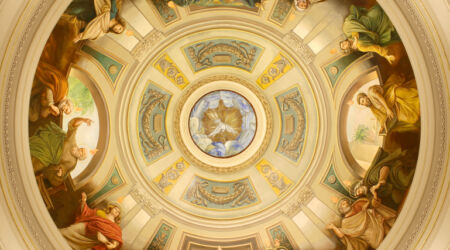The Autumn of 2020 finds Americans grappling with death in ways we have not had to in generations. As Halloween, the Feast of All Saints, and the Feast of All Souls approach, commemoration has been on my mind.
During the 2020 lockdown, I was back at my family home. Nestled into the woods on the road where I grew up is a 19th-century cemetery. As a kid, on my way up to the summit of the mountain, I liked to walk through the graveyard, read the names, and wonder at how very old or young those buried were and how long ago they lived. This year I returned to my old habit of regular climbs through the woods and up the mountain, stopping along the way to re-read the names on the graves. Convention and style of grave markers vary by tradition, region, period, and person. Most of the markers in this graveyard feature a large inscription of the honoree’s name, but omit the date of birth. Rather, the large word “died” is followed by the date upon, and age at which, each soul was born to eternal life.
Symbols of the Eternal

Photo: Jean-Pol Grandmot
Trampling through mountain laurel on my hikes, the image of grapevines coiling around the fourth-century sarcophagus of St. Constantia kept bubbling up in my mind. I first “met” her the way five million others do each year, at the Vatican Museum, where her massive stone coffin is prominently displayed in the Sala a Croce Greca. The Vatican’s overwhelming collection is host to more wonders than can be recalled, but the sarcophagus is a particularly memorable work for its color, size, and distinctive liminal imagery, which may be read in light of pagan and Christian symbolism: grapes may be Bacchanalian or Eucharistic; winged figures could be cupids or cherubs; and sheep symbolic of Mercury and of Jesus. Crafted from porphyry, a very hard purple-red stone reserved for royalty, the medium itself tells us something about who it commemorates. The carved peacocks speak to us of immortality, and while nothing terrestrial truly lasts forever, the long life of the material is suggestive of eternality.
Emperor Constantine’s rule saw Christianity transition from an outlawed religion whose adherents were tortured and martyred to toleration in 313 A.D., and the imperial order to build the original Basilica of St. Peter. Constantia, daughter of the Emperor, was baptized before her father and later canonized. As a public figure of great import to the Church, it makes sense her sarcophagus would have been moved from her mausoleum to where more of us could “meet” her. As an artifact, the tomb has many things to teach us, but it’s not the historic significance that invites me into meditation many years down the road. Its beauty and the powerful way in which it asks to be read ensure that 16 centuries after anyone who personally knew and loved Constantia in life have passed, a tangible reminder of her specific life endures.
Commemorative Works Are All Around Us

Photo: Whitney Cox
The tradition of commemoration through works of beauty isn’t a relic of the past, nor is it reserved exclusively for nationally known figures. To find very personal commemorative works in the wild, we often need only to look around: our seat at the theater or the bench we’re sitting on at the park may display the name of someone who loved the very thing we are enjoying then and there. How extraordinary that a transcendent moment of drama or repose could be gifted to you by someone in the past you have likely never met, in honor of someone they loved. We are surrounded by these gifts, but of course, most of them don’t have or need plaques. They’re the bells in the steeple, a wildflower garden, or the very beams holding up the walls of a library given in memory.
An exquisite 20th-century American example of commemorative architecture is St. Catharine’s Church in Spring Lake, New Jersey. The church was built in 1902 in memory of Catharine Maloney, a little girl who died of a childhood illness. Catherine’s Father, Martin Maloney, commissioned architect Horace Trumbauer to build the Renaissance revival church dedicated to her namesake, St. Catherine of Alexandria. The interior of St. Catharine’s is as magnificent as it is intimate. Graced with artwork by master muralist Gonippo Raggi, the architectural and liturgical artistry programs are beautiful in the classical sense, possessing clarity, harmony, and integrity.
In the Catholic tradition, every soul is called to sainthood. To be a saint is to be in heaven, in perfect union with God. There are saints, like Catherine of Alexandria, whose names are known because they been canonized (officially recognized), and countless more whose names aren’t known. The faithful on earth ask for the prayers of holy souls to aid in their terrestrial pilgrimage and pray souls not yet in that perfect state of sanctity are purified. In this way, holiness is the fruit of a community over space and time. St. Catharine’s Church interacts with this tradition in an extraordinary way, asking for intercessory prayers for Catharine Maloney by making an offering of thanksgiving to God for the gift of the brief life of the child; by honoring the ways in which the light of Christ is revealed in the life of St. Catherine of Alexandria; by placemaking in the landscape; and by offering a beautiful place to pray to all who enter the church.
Healing, Touching Lives & Inspiring Others
The act of crafting or commissioning a work of commemoration can be deeply healing. Any time we interact with beauty we are glimpsing the infinite, the source of all beauty, from whom all life flows. I was surprised by the solace I found in the simple act of selecting the music for the funeral Mass for my mother, and how designing her grave marker allowed me to “spend time” with her in a powerful way. The process is emotional but it bears gifts. It asks those involved in the act of commemoration to mediate on the legacy of the departed and offers the opportunity to share the beauty of the life mourned in hopes that the best parts of it will be magnified.

Photo: Courtesy of the St. Loius Ballet
A Ballet for Raffaella is a contemporary work of commemoration currently in development. Commissioned by the Stroik family, the ballet honors Raffaella Stroik, a gifted dancer, who died in 2018 at the age of 23. Delighting in the joy it brought others, Raffaella described ballet in transcendent terms, saying she felt “close to heaven” when she danced. Rafaella’s father, Duncan Stroik, is a renowned architect known for creating beauty in the built environment, professor at Notre Dame’s School of Architecture, and founder of Sacred Architecture Journal. I had the privilege of discussing the topic of commemoration with Stroik, who got right to the heart of the matter, “every life is eternal; how can we bring that out in a material way?”
Commemoration in the form of beauty that Raffaella was so dedicated to sharing with the world is a particularly moving tribute. Stroik reflected, “The ballet is a unique one perhaps, especially for an architect who loves physical statues, paintings, and monuments. But we create art in honor of people all the time, especially God and His Saints. Books, music, fine art all.” He was careful to point out that memorializing his daughter in this way makes no claims that she was perfect, but that each of us has the potential to do great things, and when we hold someone up to be honored, we recognize Christ in them.
Stroik described how working on the project has opened the door to conversations with people who knew his daughter in different ways than a parent knows a child, and what a blessing it is to hear stories about her. A Ballet for Raffaella is a fairy tale. It is important to the creators that it works on multiple levels: specific enough for those who knew her to see her in it and universal enough to touch those who didn’t know her. Raffaella’s family expressed the hope for commemoration succinctly, “may this ballet touch lives and inspire others.”
Great commemorative works are meaningful in an immediate way to those who mourn the specific loss, as well as those separated from the honoree(s) by space and time, who may have never known the departed in life. They are gifts of gratitude that can teach, heal, delight, and invite for generations to come.
Emily Sottile, Director of the Sacred Space Studio

